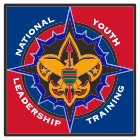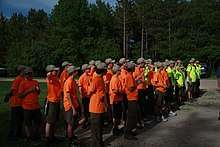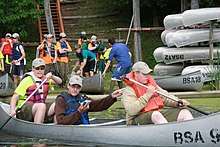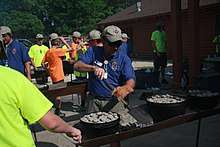National Youth Leadership Training
National Youth Leadership Training, often called NYLT, is the current youth leadership development training offered by the Boy Scouts of America. The program is conducted by councils over six days for Scouts, Venturers, and Sea Scouts. The program became co-ed in 2010. This training is a part of the national organization's leadership training program.
| National Youth Leadership Training | |||
|---|---|---|---|
 | |||
 Teams gather | |||
| Owner | Boy Scouts of America | ||
| Country | United States | ||
| Founded | 2003 | ||
|
| |||
History

In 1949 Scouts from 24 councils in 16 states formed a Junior Leader Training Troop at Philmont Scout Ranch for a forty-day training program in leadership and Scoutcraft. In 1950 the "Junior Leaders' Training Course was developed to give intensive training in Scouting skills and techniques to select Explorers. Each is trained with the end in view that he in turn will train other junior leaders. The course has four parts. The first is centered around studying leadership methods, organization, patrol method, Explorer crews, troop meetings, and camping skills. The second part deals with teaching the same skills. The third sees the trainees actually living the patrol method, using the Scouting skills. The fourth part is devoted to a model junior leaders’ conference, and projects in nature lore, special Scoutcraft skills, emergency service, and personal and group service.” In 1952 at Philmont Scout Ranch 270 participants and at Schiff Scout Reservation 436 participants completed junior leader training camps. At Schiff the program lasted for twelve days, a practice that continued until 1972.[1] In 1974 the Boy Scouts of America published the Troop Leadership Development Staff Guide.[2]
In the 1980s and 1990s, the curriculum was called Junior Leader Training (JLT). Building upon the base of JLT, in 2003 and 2004, NYLT was piloted across the country and rolled out in 2005.
In 2009 the practice of adding names like Pine Tree and Golden Acorn to the program was supposed to end.[3] Some councils ignore that policy and use Grey Wolf NYLT, Top Gun National Youth Leadership Training, Golden Falcon NYLT, Timberline NYLT, and Brownsea NYLT.[4] In 2010 Boy Scout and Venturing youth leadership training merged and the curriculum language was modified to reflect the combined nature of the program.[5]
Program
Participants are organized in teams of no more than eight, mirroring a typical local patrol and troop.[6](pStaff Guide-14) A staff member, called a troop guide, is assigned to each patrol (a team) to coach, mentor, and present some sessions and activities, much as a den chief would in a den of a pack.[6]:Day One-4 During the training the senior patrol leader performs the same function for the training cohort as a senior patrol leader does for a troop: running meetings and events, delegating responsibilities, assisting Scoutmasters, modeling learning, displaying leadership, and recruiting participation.[6](pStaff Guide-14) In addition to generally assisting the senior patrol leader, the assistant senior patrol leader is expected to oversee audiovisual support, guide the service patrol, inspect campsites, and prepare a model campsite. Some participants find the combination of technology and outdoor education problematic.[7] Administrative services and rule compliance are left to the adult supervision.[6](pStaff Guide-14) The training is presented either in a one-week format or can be split over two or three weekends. The program is often conducted at resident camps.[6](pStaff Guide-15)

The program includes patrol games and other activities used to teach event planning, communication, team development, teaching, leadership styles, setting goals, problem solving and other leadership skills. Patrols compete in lashing and a geocache game.[8] Creating a vision of success, setting goals, making plans, listening, problem solving, teaching, leading, and putting the needs of others first are all presented as important to effective leadership. The program provides opportunities to make difficult decisions using the tools of the Scout Oath and Law.[9]
The EDGE model is, and included in the NYLT programme, the EDGE model is used by Scoutmaster, an assistant Scoutmaster, or an experienced youth knowledgeable in EDGE to be taught to the troop.[10] The steps are:
- Explain — "The trainer explains how something is done."
- Demonstrate — "The trainer demonstrates while explaining again."
- Guide — "The learner tries the skill while the trainer guides him through it."
- Enable — "The learner works on his own under the eye of the trainer."
Program objectives include developing confidence, knowledge, leadership, teaching, motivation, team working, sharing ideas, sharing experiences, strengthening relationships between youth and adults, fellowship, and fun.[11] Many of the key course concepts are represented as mnemonics including planning and problem-solving tools that focus on what, how, when, and who; the start, stop, continue method of assessing progress; forming, storming, norming, performing often labeled the stages of team development; explain, demonstrate, guide, and enable or EDGE method (consult pages 38–39 in the 13th and 14th editions of the Scouts BSA Handbook which describes the Teaching EDGE method); express, address, and resolve or EAR conflict resolution tool; right vs. wrong, right vs. right, and trivial ethical decision making; message, sender, and receiver communication; and reach out, organize, practice, and experience or ROPE approach to human value.[6]:Staff Guide–3
References
- "History". NYLT Leadership Academy. 2017. Retrieved March 10, 2017.
- Troop Leadership Development Staff Guide: Troop Leader Development Staff Guide. North Brunswick, New Jersey: Boy Scouts of America. 1974.Lew Orans (April 12, 1997). "Historical Background of Leadership Development:Troop Leader Development". New Brunswick, New Jersey. Archived from the original on February 15, 2006. Retrieved September 3, 2008.
- National Youth Leadership Training. 34490. Irving, Texas: Boy Scouts of America. 2011. ISBN 978-0-8395-4490-6. Retrieved November 1, 2011.
- Grey Wolf at Northern Star Council: "About Grey Wolf Youth Leader Training". Northern Star Council. Retrieved January 9, 2020.Top Gun National Youth Leadership Training at Mecklenburg County Council:"National Youth Leadership Training Top Gun". Mecklenburg County Council. Retrieved November 9, 2011.Golden Falcon NYLT at Transatlantic Council:"Golden Falcon". Transatlantic Council. Retrieved November 10, 2011.Timberline NYLT at Utah National Parks Council:"Timberline NYLT". Utah National Parks Council. Retrieved November 10, 2011.Brownsea NYLT at Northeast Illinois Council and San Francisco Bay Area Council:"Brownsea Staff" (PDF). San Francisco Bay Area Council. Archived from the original (PDF) on April 25, 2012. Retrieved November 9, 2011.
- "Adult". Irving, Texas: Boy Scouts of America. Archived from the original on April 17, 2010. Retrieved November 1, 2011.
- National Youth Leadership Training (PDF). 34490A. Irving, Texas: Boy Scouts of America. 2005. ISBN 0-8395-4490-1. Retrieved November 5, 2009.
- Technology and outdoors: "Description of NYLT". Retrieved November 1, 2009."JLT and Woodbadge Observations". July 3, 2002. Archived from the original on January 10, 2005. Retrieved July 30, 2008."New JLT and new WB". July 3, 2002. Archived from the original on January 10, 2005. Retrieved July 30, 2008.
- "Description of NYLT". Rip Van Winkle Council. August 3–9, 2008. Retrieved November 10, 2011.
- "The Youth Leadership Training Continuum: A Guide for Scout Leaders and Parents". Supplemental Training Modules. Boy Scouts of America. Retrieved January 5, 2008.
- "Youth Leadership Training Continuum". www.scouting.org. Retrieved July 13, 2019.
- Program objectives: "BSA Vision Statement". U.S. Scouting Service Project. Retrieved July 22, 2008.Great Trail Council, BSA (2011). "NYLT" (PDF). Great Trail Council, BSA. Retrieved October 13, 2011.Pine Tree Council, BSA (2011). "National Youth Leadership Training". Pine Tree Council, BSA. Archived from the original on December 23, 2010. Retrieved October 13, 2011.Aloha Council, BSA (2011). "NYLT". Aloha Council, BSA. Retrieved October 13, 2011.Blue Ridge Mountains Council (2007). "Foxfire (National Youth Leadership Training)". Blue Ridge Mountains Council. Retrieved October 13, 2011.